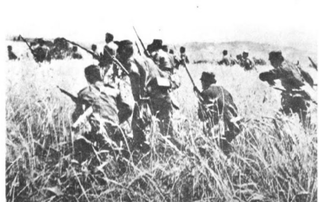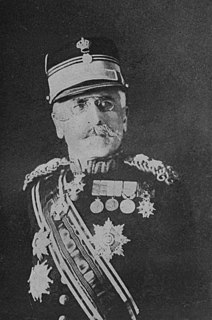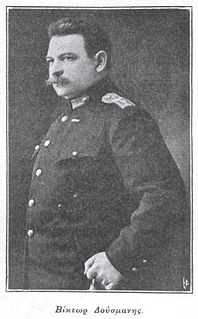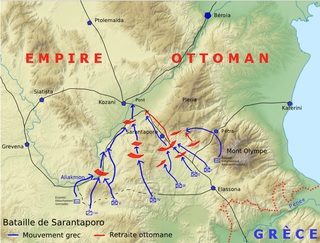
Constantine I was King of Greece from 1913 to 1917 and from 1920 to 1922. He was commander-in-chief of the Hellenic Army during the unsuccessful Greco-Turkish War of 1897 and led the Greek forces during the successful Balkan Wars of 1912–1913, in which Greece expanded to include Thessaloniki, doubling in area and population. He succeeded to the throne of Greece on 18 March 1913, following his father's assassination.

The Second Balkan War was a conflict which broke out when Bulgaria, dissatisfied with its share of the spoils of the First Balkan War, attacked its former allies, Serbia and Greece, on 16 (O.S.) / 29 (N.S.) June 1913. Serbian and Greek armies repulsed the Bulgarian offensive and counter-attacked, entering Bulgaria. With Bulgaria also having previously engaged in territorial disputes with Romania, this war provoked Romanian intervention against Bulgaria. The Ottoman Empire also took advantage of the situation to regain some lost territories from the previous war. When Romanian troops approached the capital Sofia, Bulgaria asked for an armistice, resulting in the Treaty of Bucharest, in which Bulgaria had to cede portions of its First Balkan War gains to Serbia, Greece and Romania. In the Treaty of Constantinople, it lost Edirne to the Ottomans.

The Greco-Turkish War of 1897, also called the Thirty Days' War and known in Greece as the Black '97 or the Unfortunate War, was a war fought between the Kingdom of Greece and the Ottoman Empire. Its immediate cause was the question over the status of the Ottoman province of Crete, whose Greek majority long desired union with Greece. Despite the Ottoman victory on the field, an autonomous Cretan State under Ottoman suzerainty was established the following year, with Prince George of Greece and Denmark as its first High Commissioner.
The Battle of Pente Pigadia or Battle of Beshpinar was fought during the First Balkan War between the Ottomans and the Kingdom of Greece.

The Battle of Bizani took place in Epirus on 4–6 March [O.S. 19–21 February] 1913. The battle was fought between Greek and Ottoman forces during the last stages of the First Balkan War, and revolved around the forts of Bizani, which covered the approaches to Ioannina, the largest city in the region.

The Battle of Kilkis–Lachanas took place during the Second Balkan War between Greece and Bulgaria for the town of Kilkis in Macedonia. The battle lasted three days from 19 to 21 June 1913 and ended with a Greek victory.

Panagiotis Danglis was a Greek Army general and politician. He is particularly notable for his invention of the Schneider-Danglis mountain gun, his service as chief of staff in the Balkan Wars and his participation in the Triumvirate of the Provisional Government of National Defence during World War I.

The Third Army was originally established in the Balkans and later defended the northeastern provinces of the Ottoman Empire. Its initial headquarters was at Salonica, where it formed the core of the military forces that supported the Young Turk Revolution of 1908. Many of its officers who participated in the Revolution, including Enver Pasha and Mustafa Kemal Atatürk, rose to fame and power.

The Balkan Wars Museum is a museum in Gefyra, west of Thessaloniki, Central Macedonia, Greece, dedicated to the Balkan Wars.

Konstantinos Sapountzakis was a Greek Army officer. He is notable as the first head of the Hellenic Army General Staff and as the first commander of the Army of Epirus during the First Balkan War.

The participation of Greece in the Balkan Wars of 1912–1913 is one of the most important episodes in modern Greek history, as it allowed the Greek state to almost double its size and achieve most of its present territorial size. It also served as a catalyst of political developments, as it brought to prominence two personalities, whose relationship would dominate the next decade and have long-lasting repercussions for Greece: the Prime Minister Eleftherios Venizelos, and the Army's commander-in-chief, the Crown Prince and later King, Constantine I.

Viktor Dousmanis was a Greek military officer, who rose to the rank of Lieutenant General. He distinguished himself as a staff officer during the Balkan Wars and became a leading royalist during the National Schism, serving three terms as Chief of the Hellenic Army General Staff.
The following is the order of battle of the Hellenic Army during the First Balkan War.
The 3rd Infantry Division was an infantry division of the Hellenic Army.
The 1st Infantry Regiment is a motorized infantry regiment of the Hellenic Army. Established in 1885 at Athens, it fought in all conflicts in which Greece participated until World War II, when it was disbanded following the German invasion of Greece. It was re-established as the 21st Brigade in 1945, and participated in the Greek Civil War. Receiving the designation 1st Infantry Regiment again in 1951, it was headquartered in Florina from 1952 until its disbandment in 1998. In 2013 it was re-established at Florina.

Aristeidis Chasapidis was a Greek army officer who reached the rank of lieutenant general and served as Chief of the Hellenic Army General Staff in 1935–36.





















